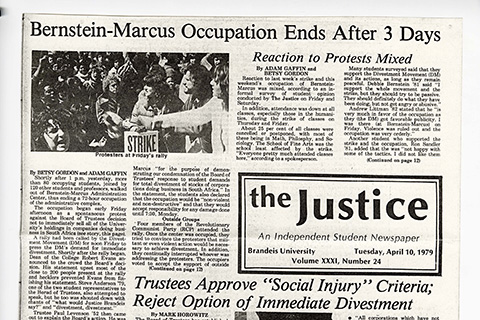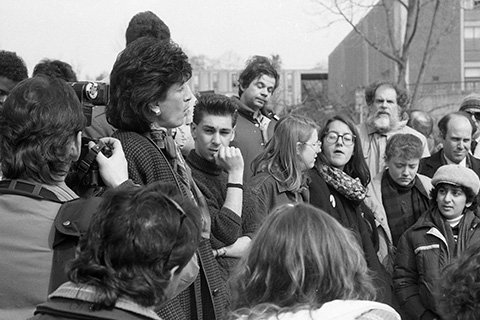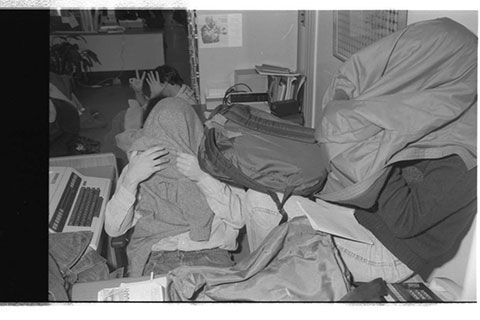Apartheid Protests and the Divestment Movement
Apartheid, an institutional system of racial segregation in political, economic, and social life, existed in South Africa from 1948 to the early 1990s. This system was met with intense protests not only in South Africa but around the world, including on Brandeis University campus. Brandeis students’ protests against the Apartheid regime spanned decades, and were particularly intense from the late-1970s to the late-1980s when the Divestment Movement was underway.
The Divestment Movement was a long-term movement by Brandeis students, faculty, and staff to pressure Brandeis’s Board of Trustees to immediately divest from companies that conduct business in South Africa. The university owned stock in fifteen companies that conducted business in South Africa, such as IBM, Kodak, and Engelhard Minerals Ltd. The stock totaled $2,884,789.50, about 8% of Brandeis’s total transferable investments. Students, as well as faculty and staff, who opposed apartheid did not want the university to indirectly provide financial support to a racist, oppressive system through its monetary investments. Many believed that divesting from these companies would compel them to pull their operations out of South Africa, thereby putting economic pressure on the South African government to end its apartheid system. Several student organizations participated in efforts to persuade the Board of Trustees and administration to divest, including the Committee for Divestment from South Africa, Divestment Movement, Divest Now, Coalition for a Just World, and Brandeis Student Anti-Apartheid Coalition. Brandeis students, alongside staff and faculty, engaged in many acts of protest, including demonstrations, class boycotts, and petitioning. They also participated in talks with the administration to urge the university to divest from all South African holdings.
Many actions were taken over the course of several years to pressure the university to divest from South Africa. The information below touches on just a few of them:

Announcement of the strike starting April 5, 1979 from the Brandeis Student Senate and The Brandeis Divestment Movement, published in The Justice. The announcement summarizes their opposition against Apartheid and their support for divestment, as well as the issues they have faced in persuading the university to divest.
 Statement from The Divestment Coalition on the shantytown they built on campus. It explains the purpose and symbolism of the shantytown and their support of divestment and the oppressed peoples in South Africa. September 11, 1986
Statement from The Divestment Coalition on the shantytown they built on campus. It explains the purpose and symbolism of the shantytown and their support of divestment and the oppressed peoples in South Africa. September 11, 1986
Students built a shantytown to replicate the shanty towns that many Black South Africans lived in in order to dramatize the effects of Apartheid, demonstrate their solidarity with Black South Africans, and to pressure the university to divest. They constructed the shantytown on Pearlman Lawn and later moved it to the front of the Bernstein-Marcus administration building in order to confront the administration with the discrimination they supported through Brandeis’s investments. The administration removed the wall of the shantytown on March 4, soon after it was moved to Bernstein-Marcus, and the students responded by occupying the reception area of President Evelyn Handler’s office the following day.
The images below show students standing in front of a shantytown that they helped build in support of divestment.
Other smaller anti-Apartheid protests and actions
Maki Mandela, Nelson Mandela’s daughter, came to speak at Brandeis on October 6, 1986. 500 students attended her talk. Following the talk, she accompanied students to the shantytown, where she affirmed her support.
 Justice article from March 4, 1986 discussing a candlelight vigil against Apartheid and students moving the shantytown from outside of Pearlman Hall to the front lawn of Bernstein-Marcus, along with photos of the events.
Justice article from March 4, 1986 discussing a candlelight vigil against Apartheid and students moving the shantytown from outside of Pearlman Hall to the front lawn of Bernstein-Marcus, along with photos of the events.
Students held a candlelight vigil to urge total divestment, as well as blockaded the entrance to Bernstein-Marcus and attempted to enter the building. In addition, four students with red paint on their faces laid down in President Handler’s office under a facsimile of the Brandeis flag that was also covered in red paint.
Below, Justice articles from March 18, 1986 detailing students' blockade of the entrance to Bernstein-Marcus and efforts to enter the building in protest against Apartheid and the university's investment policies, as well as the administration's removal of the shantytown wall.
Photos of Student Protests
Aftermath
 Reprint of the Resolution on Divestment passed by the Board of Trustees instructing the university to divest completely from all companies doing business in South Africa.
Reprint of the Resolution on Divestment passed by the Board of Trustees instructing the university to divest completely from all companies doing business in South Africa.
In May of 1987, after years of pressure from students and faculty, the Board of Trustees voted to divest from all companies doing business in South Africa (“with the exception of news organizations and health-related firms”).1














